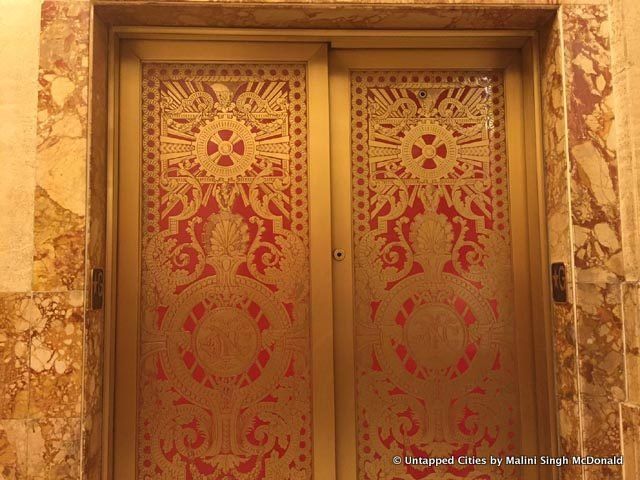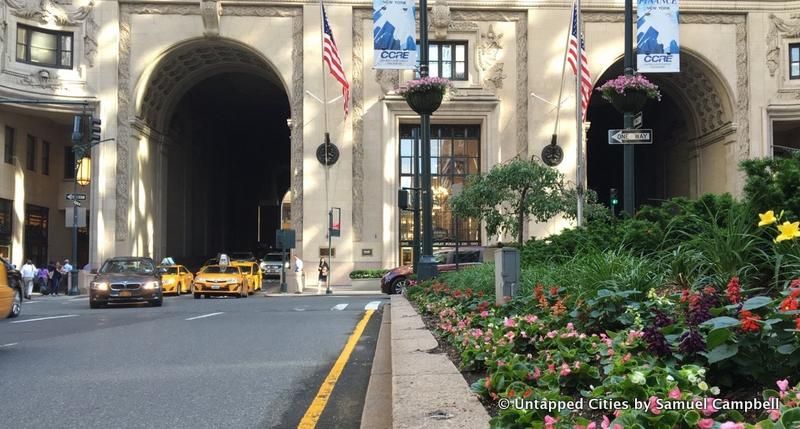100th Anniversary Great Nave Tour at the Cathedral of St. John the Divine
Celebrate the 1925 construction of the stunning nave inside the world's largest Gothic cathedral!


230 Park Avenue, now known as the Helmsley Building, is that gorgeous building on Park Avenue everyone takes photographs of, with the MetLife Building looming behind it. If you are south of Grand Central Terminal, you won’t know it’s there but if you’re looking south, you’ll see the 34-story skyscraper with the ornate cupola atop. With security standing guard, it’s a building that isn’t easy to just walk in and discover but it’s full of history and secrets. We were fortunate to be able to speak with the building’s management team to uncover many of these fun facts.
In the 1870s, as Grand Central Depot (one of the predecessors to Grand Central Terminal) was creating groundbreaking moves in train travel, the neighborhood of 230 Park Avenue still included a province of squatters and a cow pasture. However, Commodore Vanderbilt had a dream.

Warren & Wetmore designed the Belmont Hotel at 120 Park Avenue for August Belmont, in 1906 as part of Terminal City. Photo from Library of Congress, Detroit Publishing Co.
Cornelius “Commodore” Vanderbilt had a dream, which started with the creation of Grand Central Depot and expanded into the utopian Terminal City. The city was planned to encompass a community of grand residences and hotels crowned by headquarters for at least twelve blocks north of the train station on Park Avenue. The Helmsley Building was part of this large, planned complex, built as the headquarters for Vanderbilt‘s railroad, the New York Central Railroad.
Though the Commodore’s dream did not come to full fruition, much was accomplished. The railroad tracks on Park Avenue were submerged and covered. A cluster of hotels were built and many still stand, though significantly altered. The Commodore Hotel is now the Grand Hyatt New York, with a complete glass reclad. The Roosevelt Hotel is still in operation, but will close at the end of 2020. The New York Biltmore still stands but was gutted, reclad in glass and turned into an office building (now Bank of America Plaza). But inside the former Vanderbilt Hotel, also reclad in glass, you can still find the landmarked Della Robia Bar with its Guastavino tiling. Of all, the Helmsley Building may be the most true to its original design.

William Vanderbilt (Cornelius’ son and owner of New York Central Railroad) hired his cousin’s firm, Warren and Wetmore, to design 230 Park Avenue. The firm was also behind the design of Grand Central Terminal. Today, the marble, steel and bronze details still capture the essence of Park Avenue and Terminal City, and its easy to see how the Helmsley Building and Grand Central Terminal were conceived under the same conceptual idea.

The lobby, which also functions as an arcade between 45th and 46th Street, is of marble and bronze. In the Guide to New York City Landmarks, preservationist Andrew Dolkart describes the lobby as having “a sense of imperial grandeur” with details that “include extensive use of the railroad’s initials.”

Amidst the marble and bronze of the lobby, you’ll notice gilded elevators designed in a Chinese motif. The building management tells us that the elevator doors carry symbols of industry, foliage and classical imagery. But even inside, the elevator feels like an art installation. The walls are also painted in Chinese red and framed by gilded wooden molding. Then you gaze up to a cloudscape.

The clock located at the top of the entrance still reminds folks if they are on time for work or the train. It’s a nod to the New York Central Railroad business and is nine feet wide. Mercury, representing transportation, sits on the winged wheel of progress on the left, and a goddess with a beehive, grape vines, and wheat sheaves represents industry on the right.

The Park Avenue/Pershing Square Viaduct was built in ten years prior to The New York Central Building (Helmsley Building) as a way to link upper and lower Park Avenue. Also designed by Warren and Wetmore, the elevated driveways wrap around Grand Central Terminal then descend to street level at 46th Street. Traffic enters and exits through the building via the portals. The viaduct itself was landmarked in 1980.

230 Park Avenue was originally called The New York Central Building, after the railroad which had its headquarters inside. In 1968, the building was sold to General Tire and Rubber and renamed The New York General Building. General Tire and Rubber Company then sold the building to Helmsley-Spear in 1977. Harry and Leona Helmsley renamed the building, designated a landmark in 1987, “The Helmsley Building.” When the building changed hands in 1998, the new owner agreed to retain the name as a condition of sale.

The Helmsley Building also has a nefarious connection to organized crime. Salvatore Maranzano was the most powerful gangster in New York City. He had an office on the ninth floor of 230 Park Avenue which served as his headquarters. After establishing himself as the boss of bosses (capo du tutti capi), distrust was amplified. When Lucky Luciano learning that Maranzano was going to him and Vito Genevese murdered, he made a move. On September 10, 1931, Lucky Luciano placed a hit on Maranzano in his ninth floor office. Maranzano was shot and stabbed by four men claiming to be tax men. Lucky then became the boss of bosses.

Harry and Leona Helmsley were real estate tycoons who owned many buildings including the Empire State Building and the Ritz Carlton. Though 230 Fifth Avenue changed owners in the late ’90s, there are still employees (porters, engineers) of the building who once worked for the Helmsleys. Leona was given the nickname, “Queen of Mean” due to her treatment of the employees. One employee was in charge of labeling the extension sheets on all her telephones in her home. She fired her employees on a constant basis though some weren’t actually fired. Her quote “We don’t pay taxes. Only the little people pay taxes” sealed her fate and she was sent to prison for 19 months.
In 1999, The Leona M. and Harry B. Helmsley Charitable Trust was created in their name. The trust, formed after Leona’s stint in prison, aspires to improve lives by supporting exceptional nonprofits and mission-aligned organizations in the U.S. and around the world in health, place-based initiatives, education and human services. Its headquarters are located on the sixth floor of 230 Park Avenue. Leona herself passed away in 2007.
Next, read about the Top 10 Secrets of Grand Central Terminal and see more of what remains of Terminal City.
Subscribe to our newsletter